Wow- incredible workWIP----
Deckhouse planking & Trim work completed at last. I still need to install the 4 working Hinges & Door Handle Ring Bolts on the 2 Swinging Cabin doors. I will go back at a later time and do a Final paint Touchup on all the Gold Trim & other colors as needed.
Onwards...........................................................
View attachment 356857
View attachment 356858
View attachment 356859
View attachment 356860
View attachment 356861
View attachment 356862
View attachment 356863
View attachment 356864
View attachment 356865
View attachment 356866
-

Win a Free Custom Engraved Brass Coin!!!
As a way to introduce our brass coins to the community, we will raffle off a free coin during the month of August. Follow link ABOVE for instructions for entering.
You are using an out of date browser. It may not display this or other websites correctly.
You should upgrade or use an alternative browser.
You should upgrade or use an alternative browser.
1/30 HMS Royal Caroline Build
- Thread starter modelshipbuilder65
- Start date
- Watchers 72
-
- Tags
- royal caroline
Hello Rick,
If you wouldn't mind, I have been wondering for a while about the way you have chosen to present your decking. As a master modeler what is your philosophy with regard to trenails and board lengths? I have not seen the single nailing pattern used before and you have some pretty long boards and there are no butt joints on most of them.
Please don't misunderstand - I'm not being critical in any way (the rat does not tell the eagle how to fly), I'm just trying to learn how to present a model to its best advantage visually and artistically - something you are doing so marvelously.
With respect!
If you wouldn't mind, I have been wondering for a while about the way you have chosen to present your decking. As a master modeler what is your philosophy with regard to trenails and board lengths? I have not seen the single nailing pattern used before and you have some pretty long boards and there are no butt joints on most of them.
Please don't misunderstand - I'm not being critical in any way (the rat does not tell the eagle how to fly), I'm just trying to learn how to present a model to its best advantage visually and artistically - something you are doing so marvelously.
With respect!
@dockattner I Hope you don't mind if I start with the information I have obtained from my books.
Deck planking was laid in a specific pattern, in either a three or four -butt shift. This insured that the planking did not all start and finish on the same beams, which will make the system weak. The other advantage was that the shipwright would be able to lay the deck without too much wastage and with a minimum of short lengths. The deck planks were cut as long as possible since they did not have all of the problems associated with the hull planking material.
It is worth saying that each of the decks e.g. Orlop, The Gundeck, The Middle Gundeck, The Upper Gundeck, The Forecastle, The roundhouse, and The Quaterdecks are planked differently where planks have different thicknesses, lengths, and width. Defining each of the above decks would be a few pages in writing and boring for most readers. Most of the decks that were open to the elements were laid out in the four-butt shifts system. In most ships, 3in (thick) planks were used, while on smaller ships 32 guns or less the plank was only 2 1/2 in thick.
The largest width for a deck plank was in the 16th century and was about 18in maximum. In the 17th Century, the max width was found to be 15in, then it went down to 14 in the 18th, while in the 19th it had reduced to about 8 inches.
Many types of fastenings were employed for securing both the timbers and planking. Their use and their methods of fitting were governed by the material from which they were made. Wood, Iron, copper, bronze, and muntz were the most common materials, although more complex ones such as tinned iron were introduced during the 19th century.
Below are some patterns used while trenail the deck planks:


Hope this helps...
Deck planking was laid in a specific pattern, in either a three or four -butt shift. This insured that the planking did not all start and finish on the same beams, which will make the system weak. The other advantage was that the shipwright would be able to lay the deck without too much wastage and with a minimum of short lengths. The deck planks were cut as long as possible since they did not have all of the problems associated with the hull planking material.
It is worth saying that each of the decks e.g. Orlop, The Gundeck, The Middle Gundeck, The Upper Gundeck, The Forecastle, The roundhouse, and The Quaterdecks are planked differently where planks have different thicknesses, lengths, and width. Defining each of the above decks would be a few pages in writing and boring for most readers. Most of the decks that were open to the elements were laid out in the four-butt shifts system. In most ships, 3in (thick) planks were used, while on smaller ships 32 guns or less the plank was only 2 1/2 in thick.
The largest width for a deck plank was in the 16th century and was about 18in maximum. In the 17th Century, the max width was found to be 15in, then it went down to 14 in the 18th, while in the 19th it had reduced to about 8 inches.
Many types of fastenings were employed for securing both the timbers and planking. Their use and their methods of fitting were governed by the material from which they were made. Wood, Iron, copper, bronze, and muntz were the most common materials, although more complex ones such as tinned iron were introduced during the 19th century.
Below are some patterns used while trenail the deck planks:


Hope this helps...
Hello dockattner,Hello Rick,
If you wouldn't mind, I have been wondering for a while about the way you have chosen to present your decking. As a master modeler what is your philosophy with regard to trenails and board lengths? I have not seen the single nailing pattern used before and you have some pretty long boards and there are no butt joints on most of them.
Please don't misunderstand - I'm not being critical in any way (the rat does not tell the eagle how to fly), I'm just trying to learn how to present a model to its best advantage visually and artistically - something you are doing so marvelously.
With respect!
Sorry for the delay in getting back with you my good man on your Deck Planking questions you had for me. Prior to me commencing the Deck Planking, I actually gave a lot of thought on how I wanted the Deck Planks to appear on my model after some researching. After I got the copies of the actual blue prints of the RC from the National Maritime Museum, Greenwich, London, I was able to confirm the actual width of the Deck Planks. The Royal Carolines Deck Planks measure approximately 5.75" inches Wide. Deck Planks of this width were usually (but not always) attached with a single Treenail or a threaded Lag type of Bolt & then a Single Dowel was used to cover the Treenail Head. I have a Book-- Rees's Naval Architecture 1819-20 that also discusses the use of Treenails and confirms this and the information previously posted by Jimsky.
The Longest Plank for the Cabin Deck was just under 21' long and no Butt Joints were needed or required for this length. Planks Longer than 22' feet in Length were normally not used in this length or for this Deck application. Some other reasons (not limited to) Butt joints NOT being used was to minimize Splinting, wood checks and to help the ease of caulking to prevent water leakage and it also helped to create a uniform surface for sailor usage of the Deck.
At the end of the day, I decided to go this route based on what Literature & research I have done/read and I have yet to see any other Royal Caroline be done this way.
By no means Do I consider this the Final say because without actual drawings or prints of the Original Royal Caroline Deck Treenail layout, one can only speculate as to what was actually done originally but at the end of the day, I like the appearance.
Hope this helps --Rick


Last edited:
WIP----
Hello everyone. Got the Aft Railing on the Port & Starboard side Fitted & completed. The 2 cabin doors Hinges are also completed & attached to the 2 swinging doors along with the Doors Ring Bolts. I will attach the 2 cabin doors permanently at a later time after I clean them up and do a little filler & touch up work .
I will also go into more depth at a later time about the kits inaccuracy concerning the Railings......








Hello everyone. Got the Aft Railing on the Port & Starboard side Fitted & completed. The 2 cabin doors Hinges are also completed & attached to the 2 swinging doors along with the Doors Ring Bolts. I will attach the 2 cabin doors permanently at a later time after I clean them up and do a little filler & touch up work .
I will also go into more depth at a later time about the kits inaccuracy concerning the Railings......








Last edited:
Thank You SirThis is just in another league, Rick! Well done, my friend!
Thank you for taking the time to post such a complete answer (and also to @Jimsky). I appreciate the opportunity to learn from the masters.Hello dockattner,
Sorry for the delay in getting back with you my good man on your Deck Planking questions you had for me. Prior to me commencing the Deck Planking, I actually gave a lot of thought on how I wanted the Deck Planks to appear on my model after some researching. After I got the copies of the actual blue prints of the RC from the National Maritime Museum, Greenwich, London, I was able to confirm the actual width of the Deck Planks. The Royal Carolines Deck Planks measure approximately 5.75" inches Wide. Deck Planks of this width were usually (but not always) attached with a single Treenail or a threaded Lag type of Bolt & then a Single Dowel was used to cover the Treenail Head. I have a Book-- Rees's Naval Architecture 1819-20 that also discusses the use of Treenails and confirms this and the information previously posted by Jimsky.
The Longest Plank for the Cabin Deck was just under 21' long and no Butt Joints were needed or required for this length. Planks Longer than 22' feet in Length were normally not used in this length or for this Deck application. Some other reasons (not limited to) Butt joints NOT being used was to minimize Splinting, wood checks and to help the ease of caulking to prevent water leakage and it also helped to create a uniform surface for sailor usage of the Deck.
At the end of the day, I decided to go this route based on what Literature & research I have done/read and I have yet to see any other Royal Caroline be done this way.
By no means Do I consider this the Final say because without actual drawings or prints of the Original Royal Caroline Deck Treenail layout, one can only speculate as to what was actually done originally but at the end of the day, I like the appearance.
Hope this helps --Rick
View attachment 357556
View attachment 357557
WIP----
Hello Everyone, everywhere. I have been working on the Midships Bulwarks. Got the Port & Starboard Planksheers (rails) & the 3x4mm Blocks cut and attached. I have not attached the Upper (Fife) rails as of yet because I still have some details on the Forecastle to be done along with finalizing & prepping for the Port & Starboard Boarding Stanchions. I also cut out the opening on each side of the Forecastle Carving Frieze as the plans show & the Original National Maritime Museum Copies also show this area open. I will be recoating ALL the Rails Flat Black & Sealing after the Final assembly is completed...............................



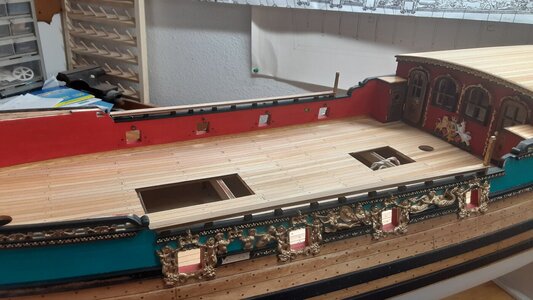
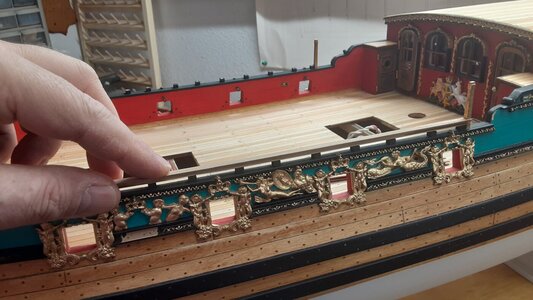

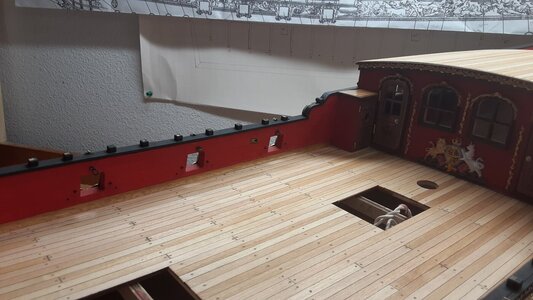

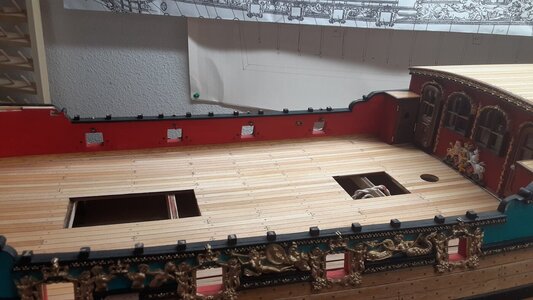
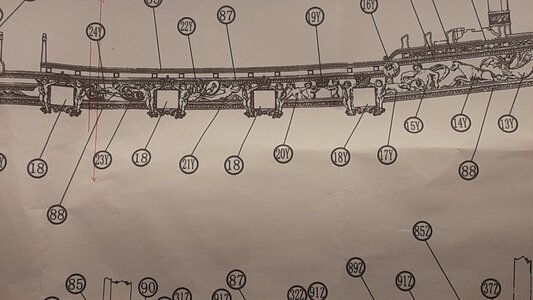
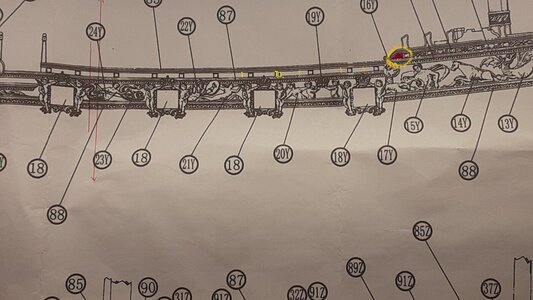
Hello Everyone, everywhere. I have been working on the Midships Bulwarks. Got the Port & Starboard Planksheers (rails) & the 3x4mm Blocks cut and attached. I have not attached the Upper (Fife) rails as of yet because I still have some details on the Forecastle to be done along with finalizing & prepping for the Port & Starboard Boarding Stanchions. I also cut out the opening on each side of the Forecastle Carving Frieze as the plans show & the Original National Maritime Museum Copies also show this area open. I will be recoating ALL the Rails Flat Black & Sealing after the Final assembly is completed...............................











Thanks Heinrich my Friend!!!! LOL on your railing comment, hehehehehehehe. Yes, they can be a pain in the rear-end for sure!!! I used my electric chop saw to cut the 3x5mm blocks. It was nice because the saw cut them square & I could cut a lot in a short time.Superb Rick!. Railings and I are not good friends, but you got these down to a T! I am sure you are happy with how those turned out.

WIP---
Hello everyone. Been working on the Forecastle Deck & Knightheads and the Bowsprit bollard assembly. I had to mill out the sheave openings in order for the brass sheaves to fit properly. I also had to relocate the Decks hole for the Foremast slightly aft in order to get the correct Mast taper. More to come...............


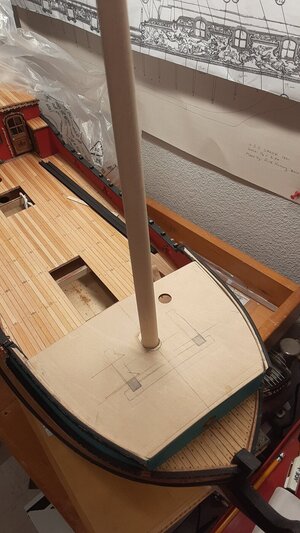



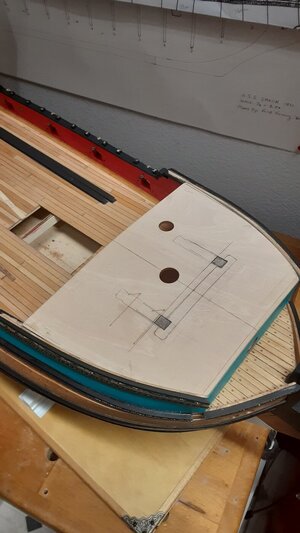
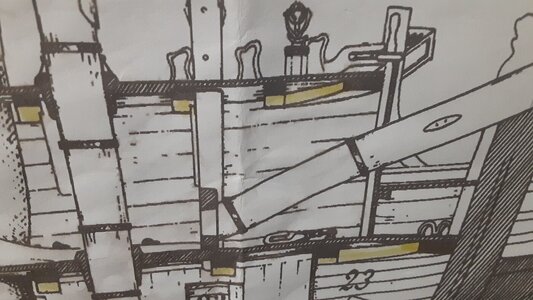
Hello everyone. Been working on the Forecastle Deck & Knightheads and the Bowsprit bollard assembly. I had to mill out the sheave openings in order for the brass sheaves to fit properly. I also had to relocate the Decks hole for the Foremast slightly aft in order to get the correct Mast taper. More to come...............








Carving is probably my weakest skill in all model building. I am going to use the kits figure and I'll do some cleanup on her. I don't have your skills with carving. Your figure head turned out really nice!!!!I feel it comming, you will carve your own figure head.
WIP----
Hello Everyone, Everywhere. I have been working on the Lower Knighthead Timbers and Bowsprit Cap Timbers. Builders of this particular kit will, at a minimum, have to make their own Bowsprit Cap Timbers (or something to secure the Bowsprit) because the kit manufacture 'supplies nothing' whatsoever in building materials!!! The insufficient instructions only draw your attention to the Plans in which is just a enlarged copy from the book "Anatomy of the Ship" series for the Royal Caroline.
I sincerely applaud Maartens' 1:30 Royal Caroline build because as of this time, his is the only other build I have seen who has attempted & succeeded in building the Lower Knighthead Timbers and Bowsprit Cap Timbers. I don't understand why the manufacture didn't include building material's because this area under the Forecastle is clearly visible even when the Deck is fully covered unlike Maartens (and so many, many more details can be seen under his Forecastle than mine)!!!!!
I am just dry fitting all the items at this time in the photo's. More to come...........................................



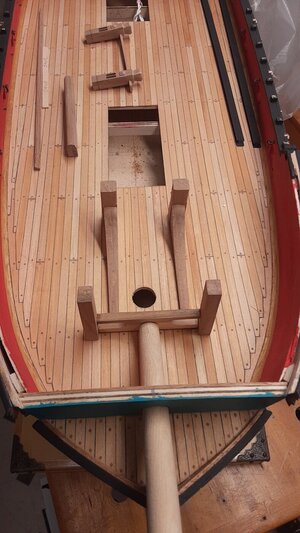
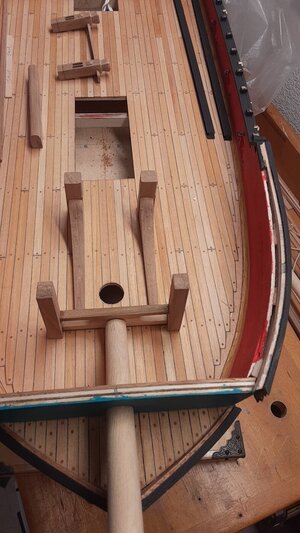


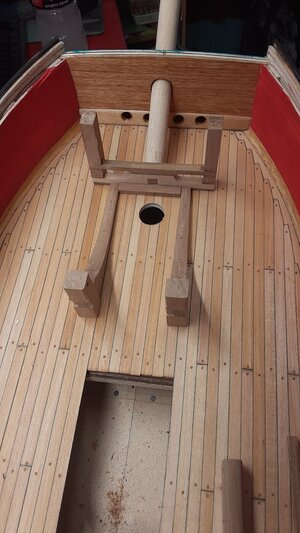


Hello Everyone, Everywhere. I have been working on the Lower Knighthead Timbers and Bowsprit Cap Timbers. Builders of this particular kit will, at a minimum, have to make their own Bowsprit Cap Timbers (or something to secure the Bowsprit) because the kit manufacture 'supplies nothing' whatsoever in building materials!!! The insufficient instructions only draw your attention to the Plans in which is just a enlarged copy from the book "Anatomy of the Ship" series for the Royal Caroline.
I sincerely applaud Maartens' 1:30 Royal Caroline build because as of this time, his is the only other build I have seen who has attempted & succeeded in building the Lower Knighthead Timbers and Bowsprit Cap Timbers. I don't understand why the manufacture didn't include building material's because this area under the Forecastle is clearly visible even when the Deck is fully covered unlike Maartens (and so many, many more details can be seen under his Forecastle than mine)!!!!!
I am just dry fitting all the items at this time in the photo's. More to come...........................................










Very nice and sharp work Rick.
Thank youVery nice and sharp work Rick.
Oh Ja - very accurate and exact work - Very good 

Nice work Rick, she's looking good ,
best regards John,
best regards John,
Thank youNice work Rick, she's looking good ,
best regards John,
















